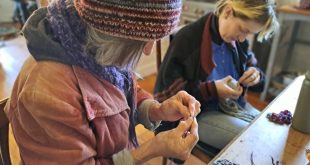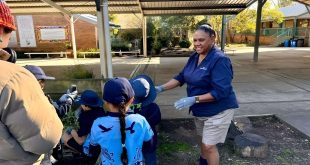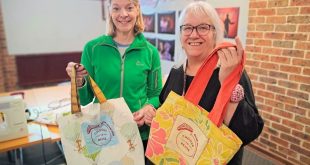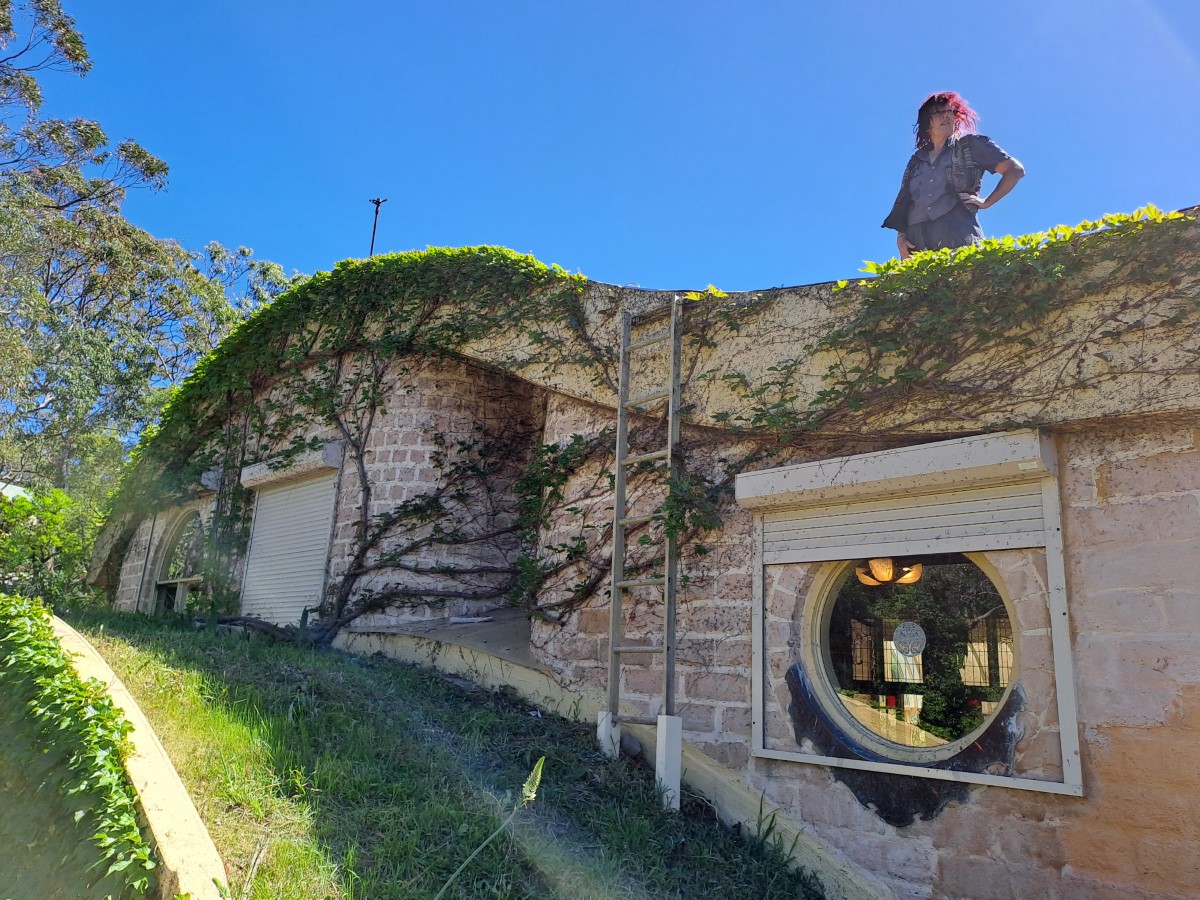
Marilyn Pride at her mudbrick green roof home in Linden
Story and photos by Belle Butler
A green roof, with soil and a vegetation layer, reduces energy use, boosts biodiversity and reduces bushfire risk. Read about a home in Linden where the owners have enjoyed the benefits of their green roof for over 30 years.
Key Points:
- A house with a green roof doesn’t take land space away from nature
- Green roofs reduce heating, cooling, fire risks, pollution and stormwater runoff
- Biodiversity increases with green roofs.
Taking a bird’s eye view of Marilyn Pride and Lewis Morley’s home in Linden, you might wonder if you are looking down at a house at all. The usual hard surfaces of rooftop and edge are nowhere to be seen. Instead, there are the undulating, soft and blended curves of grass, flower and earth. Here, the stark contrast of development upon nature is avoided by integrating nature into development, in the form of a green roof.
Marilyn and Lewis built their mudbrick home in 1992. They originally wanted a thatched roof, but that being an impossibility due to fire risk, they discovered the benefits of topping their home with soil and vegetation instead.
“A green roof doesn’t take away from the footprint of the land. It’s still got plenty of greenery and foraging plants for the bees up there, so it’s keeping the same land space for growing.” – Marilyn Pride
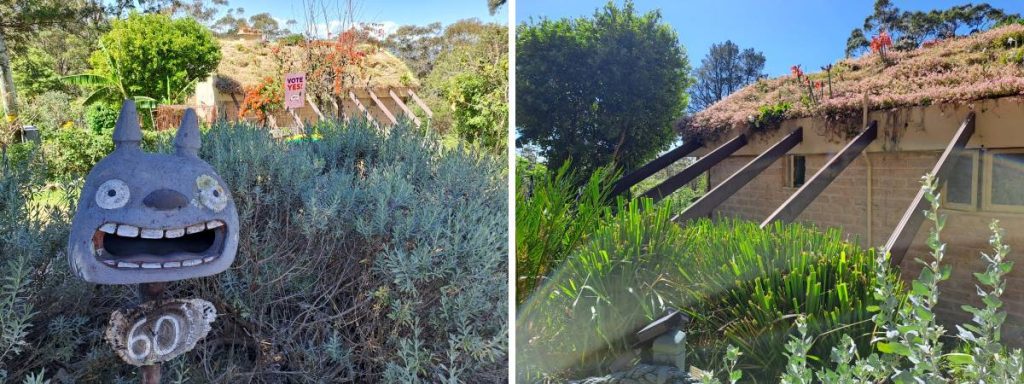
Left: Totoro the ‘nature spirit’ is an intentional symbol of environmentalism that welcomes you to Marilyn and Lewis’ house. Right: Marilyn and Lewis’ green roof house blends in with surrounding vegetation.
This rationale is echoed by eco-architect and artist Friedensreich Hundertwasser who was renowned for his strong advocacy for green or ‘afforested’ roofs. He inspired many small and large scale ‘afforested’ developments around the world.
“It is our duty to put the nature, which we destroy by building the house, back onto the roof. We must give territories back to nature which we have taken from her illegally.” – Friedensreich Hundertwasser
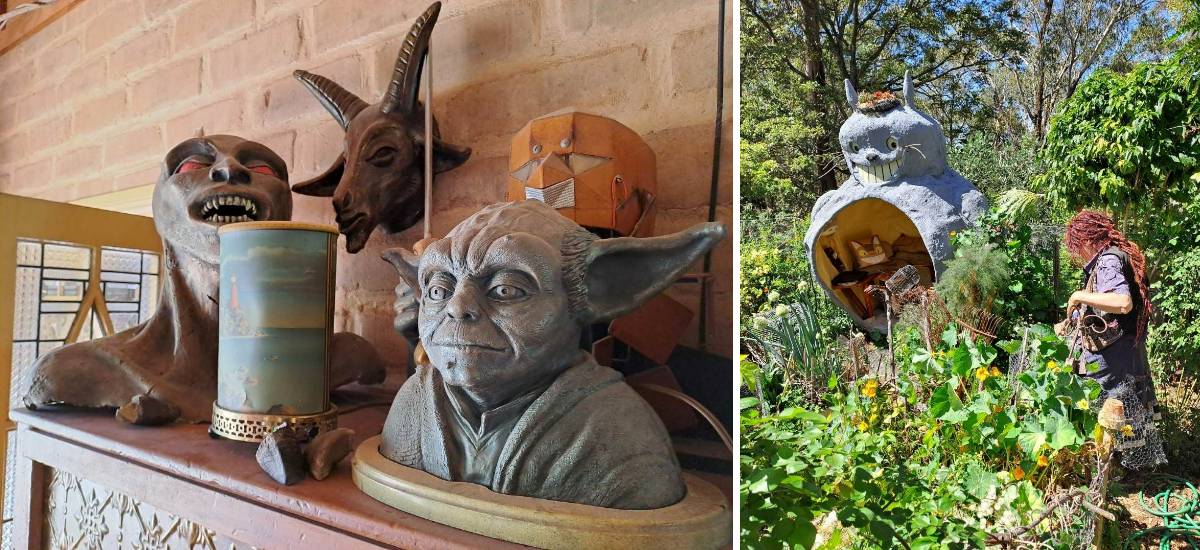
Left: Some curiosities from Marilyn and Lewis’ work in the film industry. Right: Marilyn in her garden with a giant Totoro sculpture/cubby space Lewis created.
Visiting Marilyn and Lewis’ house is, indeed, a bit like visiting a Hundertwasser creation. Flowers bask in the full sun upon their roof, and inside the place is full of artistic quirks and curiosities from their time working in the film industry making sculptures and sets. “The local kids call it the Linden Museum,” Marilyn says. The sweeping curve of their roof is a particular treat for the eye. But aesthetics aside, Marilyn and Lewis’ green roof serves multiple environmental functions.
According to an Australian government guide to sustainable housing, green roofs:
- provide improved insulation, which reduces heating and cooling needs
- help with stormwater management by reducing and slowing runoff
- absorb noise
- produce oxygen and capture carbon
- absorb gaseous and particulate pollutants
- reduce the urban heat island effect
- increase biodiversity
Marilyn cites most of these facts when rationalising her decision to build a green roof, and the payoff has been noticeable. Her roof provides habitat and food for various creatures, including countless insects and the native antechinus. It also keeps the human inhabitants beneath it comfortable all year round. “We don’t have any air conditioning,” Marilyn says. “We have metal shutters for fire protection and to block out heat, and that’s it.”
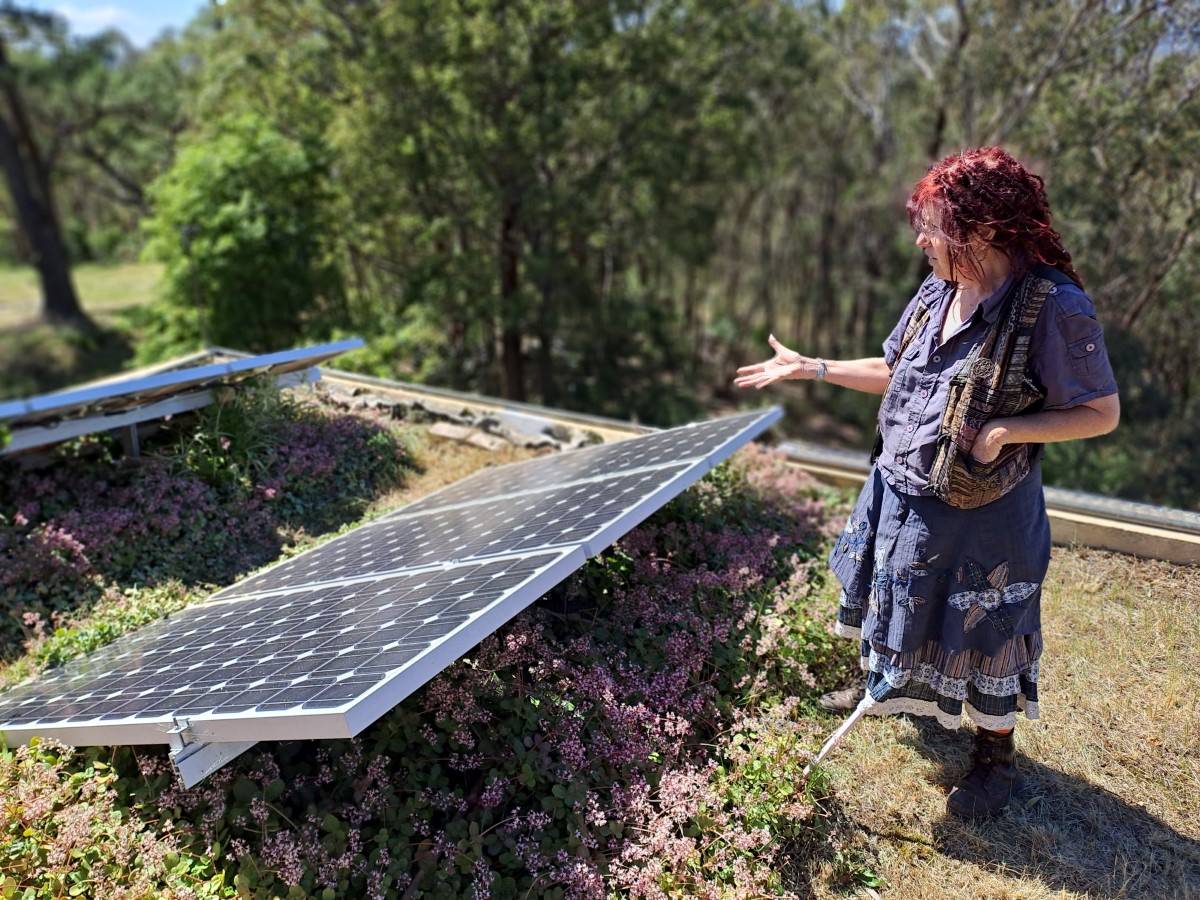
Green roofs can also accommodate solar panels.
A green roof’s capacity to reduce the heat island effect is a significant benefit for individuals and whole communities alike as we face hotter seasons ahead. While the hard surfaces of conventional roofs store and radiate heat, green roofs actually take heat out of the air via evapotranspiration.
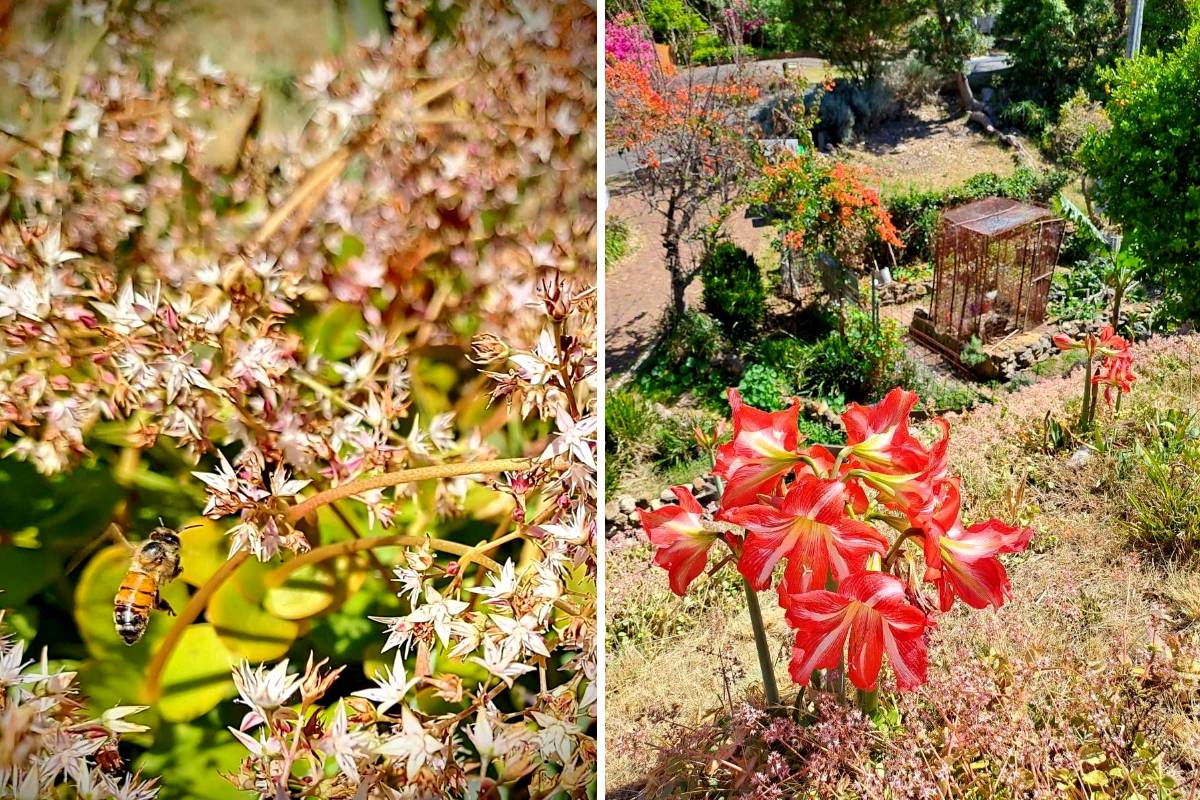
Left: Spot the bee among the rooftop flowers. Right: Flowers basking in the sun on Marilyn and Lewis’ green roof.
Another clear benefit of the roof is that it is resistant to fires. “Green roofs are inherently more fire resistant that conventional roofing,” says architect Nigel Bell of ECOdesign Architects, who has been familiar with Marilyn and Lewis’ home since shortly after its construction. “Earth is solid, always more than 90 mm thick, which is all you need for the most intense fire. Theirs (Marilyn and Lewis’) is 300mm. The low vegetation on top will burn, but it’s not a big deal. The thick earth will protect everything underneath.”
Fire is a consideration Marilyn and Lewis have taken seriously on their property, adopting practical steps to reduce the risk. Aside from opting for a green roof, Lewis replaced all wooden gates on the property with his own custom-made pressed metal gates; they used metal materials in the construction of their deck; they installed a large, metal-walled water tank and petrol-powered pump, which feeds a sprinkler system on the roof; and they installed metal shutters on all external windows.
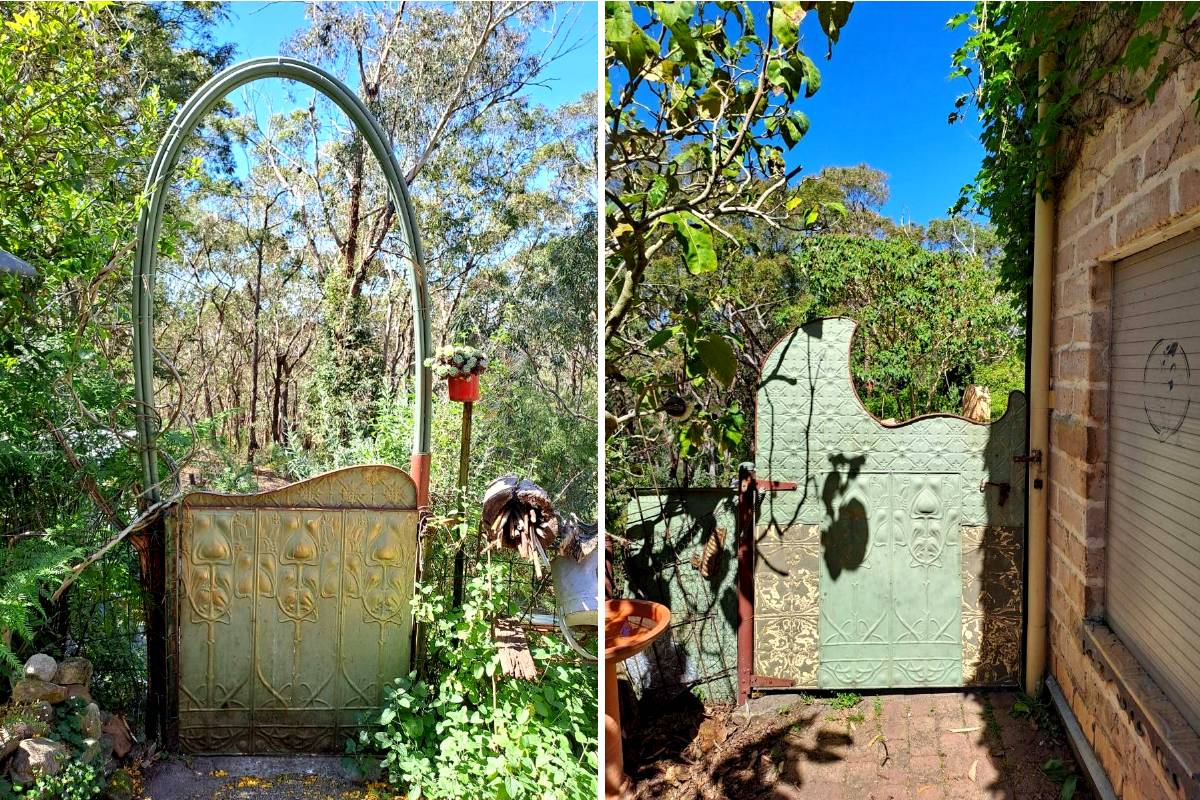
Lewis created pressed metal panel gates in place of the original wooden ones in order to reduce fire risk.
Despite the clear benefits of having a green roof, they are not a common sight. Nigel suspects one possible imposition is the need for an experienced engineer to do this specialised work. Marilyn also cites getting the weight-bearing right as an important aspect of any green roof build. In the case of their Linden home, using load-bearing mudbricks made the project more feasible.
In terms of upkeep, Marilyn occasionally tends to her roof with a whipper-snipper and provides additional watering if there isn’t much rain. She mostly keeps low maintenance succulents up there, which are also a wise choice in the event of fire. The occasional leak has occurred, usually due to wandering grass roots, but these are easily fixed by pulling up the layer of earth where the leak is and replacing the waterproofing sheet underneath.
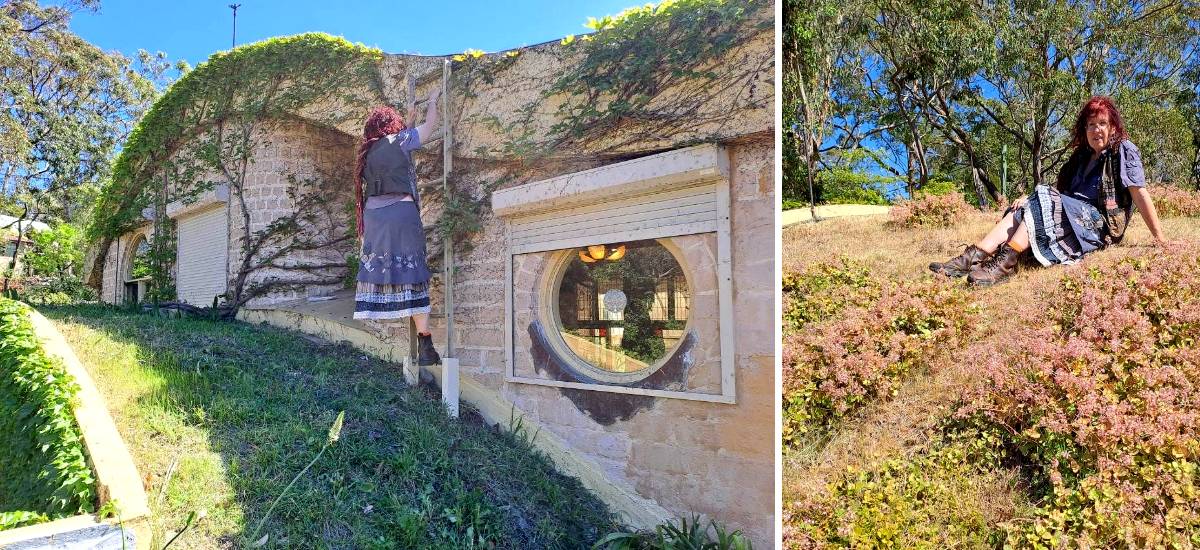
Left: Marilyn climbs up a ladder to the top of her green roof. Right: Marilyn sitting on the hill of her roof.
Perhaps the most underrated perk of a green roof is the delight in sitting on top of it. After our conversation, Marilyn and I step onto the flat roof of her garage where she once grew potatoes and now keeps a healthy crop of spring onions. We then climb a small ladder to the main roof, and I delight in walking to the top of it, just as I might any grassy hill. The insects are busy foraging. The sun is warm. As I sit on the gentle slope I contemplate having a nap among the bees.
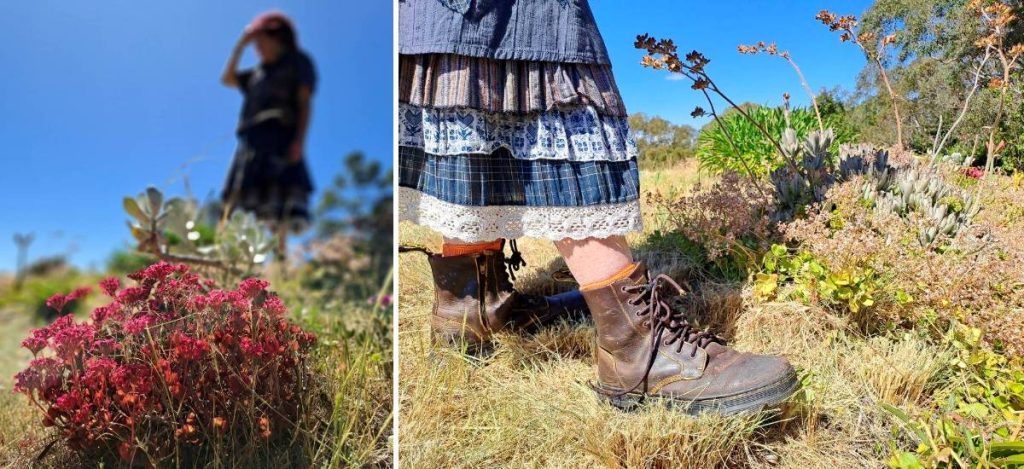
There is a special delight in walking on a grassy roof.
Take Action:
Share this article:
This story has been produced as part of a Bioregional Collaboration for Planetary Health and is supported by the Disaster Risk Reduction Fund (DRRF). The DRRF is jointly funded by the Australian and New South Wales governments.
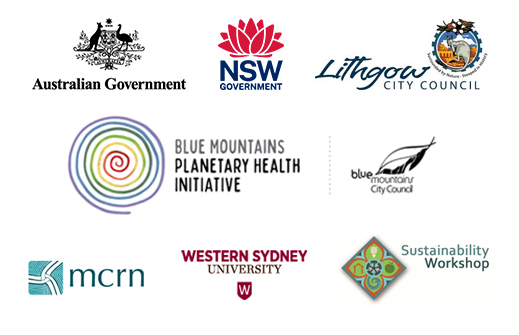
More from around the region
The fabulous Gang Gang Farmers Market in Lithgow will be back when the weather warms up. Meet some stallholders and whet your appetite for their Spring re-opening in Lithgow Area Local News (link in profile)
https://lithgowlocalnews.com/gang-gang-farmers-market/
#markets #lithgow #localproduce #planeteryhealth #buylocal
Imagine having enough absorbent green spaces, water tanks and underground water storage to capture the damaging stormwater that runs off hard surfaces in extreme wet weather events; imagine having enough stored water and the ability to clean all the water we use so that we are prepared for future drought and fire seasons. Join the discussion about how we can do this at a Free Water Symposium on Friday 26 July at the Planetary Health Centre. Bookings essential (link in profile): https://www.eventbrite.com.au/e/future-proofing-with-circular-water-tickets-943977701717
#circularwater #greywater #blackwater #stormwater #waterrecycling #togetherwecan #disasterriskreduction #beprepared #extremeweather #planetaryhealth #bushfire #flood #drought
Beyond the Yellow Bin: Surprising Things You Can Recycle – and How to Do it!
Here’s a guide to help Springwood and Greater Blue Mountains residents access the most effective recycling options available in the local area. Read more in Springwood Area Local News (link in profile): https://springwoodlocalnews.com/recycling-in-the-blue-mountains/
#recycling #circulareconomy #reuse #reduce #recycle #bluemountains #springwood #planetaryhealth #togetherwecan
Hamish Dunlop interviews prize-winning children’s book illustrator, mother, activist and proud Bundjalung woman, Charmaine Ledden-Lewis about the power of storytelling and how we can inspire our children to build a better world. Read more in Blackheath Area Local News (link in profile): https://blackheathnews.com/charmaine-ledden-lewis/
#changethestory #abetterworld #powerofstorytelling #bundjalung #illustrator #firstnations #planetaryhealth #blackheath #bluemountains
Broken chair? Blown amp? Busted washing machine? They don’t have to be thrown away! These Mid Mountains fixers and makers will revive them. Read more in our Mid Mountains Repair Guide: Choosing Longevity in an Age of Disposability. You can find it in Mid Mountains Local News (link in profile): https://www.midmtnslocalnews.com/mid-mountains-repair-guide/
#repair #repairculture #fixing #reuserecycle #longevity #togetherwecan #thebigfix #planetaryhealth #midmountains #repairguide
In this video, Dharug artist Leanne Tobin talks eloquently about the critical importance of water and why it`s the theme of her two paintings in the Water for Life exhibition at the Blue Mountains Planetary Health Centre. View the paintings and learn more about the many ways we can work together to manage water better at our free Water Symposium next Friday 26th July. Bookings essential (link in profile): https://bit.ly/3LiuJWi
The full video can be viewed on our YouTube channel (link in profile)
#waterforlife #leannetobin #firstnations #waterissacred #planetaryhealth #watersymposium
Electric vehicles continue to grow in popularity across Australia, but many people are still uncertain about their benefits, feasibility, and availability. To try and help local communities in the Lower Mountains have a better understanding of what EV’s can offer, @parentsforclimatebluemountains are hosting an EV Showcase in Blaxland on Saturday 27 July to help bust the EV myths and provide helpful, up-to-date and accessible information. 33 Hope Street Blaxland between 10 am and 12.30 Read more in Lower Mountains Local News (link in profile): https://lowermtnslocalnews.com/community-ev-showcase-blaxland/
#electriccars #blaxland #bluemountains #ev #planetaryhealth #towardszeroemissions
As part of our Water Demonstration Site at the Blue Mountains Planetary Health Centre we`ve installed a range of sprinklers to show people how to protect their homes from bushfire. Plumber Daniel Brown will be giving a tour at our upcoming event: Future Proofing with Circular Water on Friday 26 July. The event is free but bookings essential at https:bit.ly/4f78K1Z (link in profile) #bushfiresprinklers #beprepared #planetaryhealth
Global problems are creating renewed interest in traditional DIY skills like sewing. Here’s how a local grandmother is sharing her rag trade experience to make a difference and how you can get involved. Read more in Katoomba Area Local News (link in profile): https://www.katoombalocalnews.com/upcycling-fashion-workshops/
#skillshare #givingback #sharing #upcyclingfashion #sewing #patternmaking #repair #clothingadjustments #wastereduction #textilewaste #creativity #planetaryhealth
Calling all plumbers, builders, architects, engineers and any community members interested in learning ways we can manage water to reduce the impact of future droughts, floods and fires. On Friday 26 July we`ll be bringing together leaders in bushfire sprinkler system design, Hydraloop technology which can recycle 40% of your greywater, the program manager for drought from Sydney Water, and the designer of our 150,000l underground water storage system which will be capturing and cleaning stormwater for firefighting as a model for what we could build at the end of flame zone streets. Speak to a plumber about installing tanks and water systems and be in the running to trial one of two free Hydraloops we have on offer. This grant-funded event is free but bookings essential (link in profile):
https://bit.ly/4f78K1Z
This event is being supported by the Disaster Risk Reduction Fund which is funded by the Australian and New South Wales governments.
@hydraloop_systems @sydneywater @nswreconstructionauthority #greywaterrecycling #watertanks #firefighting #beprepared #drought #fire #flood #heatwave #bushfiresprinklers #planetaryhealth #disasterriskreduction
Our fortnightly Planetary Health Newsletter shares news about upcoming events, like our free Water Symposium on Friday 26 July, and stories from the Lower Mountains to Lithgow that are jam-packed with inspiration and a blueprint for the way forward.
Read it here and subscribe via any of our news sites (links in profile):
https://bit.ly/4cXQg2f
In this edition:
Katoomba Area Local News: Learning How To Upcycle Fashion with Sherlie McMillan
Mid Mountains Local News: Mid Mountains Repair Guide: Choosing Longevity in an Age of Disposability
Blackheath Area Local News: Charmaine Ledden-Lewis on Stories for a New World
Lower Mountains Local News: Busting The EV Myths: Community EV Showcase & Information Event Comes to Blaxland
Springwood Area Local News: Beyond the Yellow Bin: Surprising Things You Can Recycle – and How to Do it!
Lithgow Local News: The Gang Gang Farmers Market will Return in Spring!
#planetaryhealth #systemicchange #togetherwecan #solutions #constructivejournalism #watersymposium #hyperlocalnews
What an inspiring day at the Planetary Health Centre yesterday! We launched the Planetary Health Storytelling Network after a brilliant workshop with award-winning health writer and author Sophie Cousins on Our Community, Our Stories: Writing for Change. The Network will include all types of storytelling for planetary health: from songwriting to video, creative non fiction and visual arts. We`ll be having our first reading by Lorraine Shannon on the theme of GARDENS at 6.30pm on Thursday 8 August. All welcome to come along and share. SAVE THE DATE!
#planetaryhealth #changethestory #togetherwecan #storytelling #storytellingforchange #planetaryhealthstorytellingnetwork


